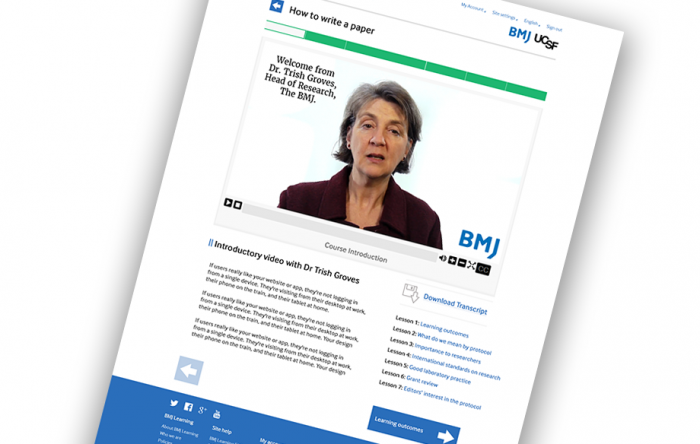The Challenge:
There was growing evidence that a programme to help low to middle-income countries (LMICs) develop a high-quality local clinical research capacity – essential to tackling local healthcare challenges – may be attractive to governments, institutions, non-governmental health organisations and individuals. We wanted to test that hypothesis.
Some Background:
The BMJ believed there was an opportunity to help medical academics in emerging economies develop their research expertise by providing “a gold standard online programme of self study courses on clinical research methods and publication”.
A gap existed between superficial workshops and online resources provided by STM publishers and the expensive and limited postgraduate courses provided by some local institutions. Our aim was to fill that gap.
Main Objectives:
First, however, we had to test our hypothesis. To do so, the focus had to be on obtaining early feedback, making quick decisions and reducing the risk of developing a market-less product. In other words, getting an MVP (minimum viable product) out the door as soon as possible.
My Role:
I was Lead UX/UI Designer on this project. I facilitated a discovery workshop with stakeholders to generate conceptual designs for our MVP and, based on these concepts, developed a prototype iteratively through internal user testing. Using customised open-source software, I developed our final MVP learning content (audio / video) and created the necessary brand assets and hi-fi UI designs.
// Conceptual Design for our MVP
(click to enlarge) //
I also lead other Lean UX activities such as hypothesis development to promote a unified approach and a common goal amongst team members (see graphic) and created a Lean Analytics framework by which to track and assess project viability.
// A Lean Analytics Framework
(Click to enlarge) //
Once we were in Sprint mode, I worked on the frontend development of the MVP (and later our MMP).
Our Users:
Low and Middle Income Country (LMIC) early career academics in healthcare research, and their institutions.
UX Design & Research:
Approach:
Embracing a Lean UX methodology, we dispensed with the usual requirements gathering in favour of using a single “problem statement”. This lead to a set of assumptions that we used to create our hypotheses.
Problem Statement: “We have evidence that early career researchers find it almost impossible to get published in international journals because of under-developed research and writing skills. A gold-standard, affordable, flexible online course addressing both methodology and academic writing and focused entirely on medical research, will see improved research quality and acceptance rates which will drive career progression, funding and status for individuals and institutions”
In true Lean UX fashion, our assumptions were developed from the problem statement above.
Sample Business Assumptions:
- I believe my customers have a need to get published in international medical journals
- These needs can be solved with a flexible online course addressing both methodology and academic writing and focused entirely on medical research
- My initial customers will be early career academics and their institutions in LMIC’s.
Sample User Assumptions:
- Users will benefit from this product because it addresses the issue of underdeveloped research and writing skills
- The product can be used at a time and location at the will of by the user
- This product will solve the struggles LMIC early career academics have in getting medical research written and published in academic journals.
We then set about prioritising a set of assumptions to test based on their level of risk (How bad would it be if we were wrong about this?).
Hypothesis Statement
The next phase involved generating a hypothesis statement to test our assumptions against. Hypothesis statements use the format:
We believe [this statement is true]. We will know we’re [right/wrong] when we see the following feedback from the market: [qualitative feedback] and/or [quantitative feedback] and/or [key performance indicator change]
Our generated hypothesis statement:
We believe that by providing a gold-standard, affordable, flexible online course, we will drive career progression, funding and status for early career academics and institutions. We will know we’re right when we see improved research quality and acceptance rates for these users.
The outcomes we wanted to achieve:
“Africa’s share of annual research publications on health rose from 0.7% in 2000 to 1.3% in 2014, with just three countries – South Africa, Nigeria, and Kenya – contributing over half.” (Uthman OA, Wiysonge CS, Ota MO, et al, 2015). This was the KPI that we wanted to effect and here was the reason why…
Universities and medical schools use publication output to monitor the efficiency and effectiveness of their research efforts, to climb up the academic league tables, to grow internationally strong reputations, to attract funding and high calibre undergraduate and postgraduate students, and to build long term capacity to generate usable evidence and improve health.
Trish Groves, Head of Research, BMJ
Our MVP:
- I met with business stakeholders to run a workshop over the course of an afternoon, out of which emerged a conceptual design for our MVP.
- It was decided that our MVP would include just 2 free starter courses while we awaited sign-off on additional course material. Other features from our conceptual design were de-prioritised (accreditation; exam scores etc) as unnecessary for hypothesis testing / MVP launch.
- We took inspiration from more mature online edTech products for our journeys.
- We used free open-source software to build our instructional videos (PopcornJS – previously of Mozilla, now defunct).
- We piggy-backed on one of our existing products to host the content and to handle user onboarding and subscription management.
// Visual assets; branding & UI Design
(click to enlarge) //
Some thoughts:
Given the speed with which we delivered the MVP, this project was an interesting ride! While effort was made to adhere to out ‘Lean’ approach, we admittedly needed to take a few shortcuts. We could have done more work with (proto-) persona development. This was one area that was perhaps under explored as we worked towards a hard deadline.
Furthermore, we could have segregated our users and customers more definitively when undertaking our Lean activities and developing our assumptions and hypotheses.
Also, while light on deliverables, Lean UX does demand a certain rigor, and reaching a point of cadence proved somewhat difficult. Perhaps this was a result of the short time the project team had together, with just a few sprints sprints to build the necessary rhythm – and efficient collaboration – required. That said, as a first attempt, the project did run pretty well.
Importantly, we were guarded against some of the better known anti-patterns that can cause such projects to fail. We had a PO who understood the process – or at least was willing to invest time in trying to do it right (the inmates were not running the asylum; the project was design-led; the team was kept small; everyone spoke the same language and had a shared understanding of what we were trying to achieve).
Results / Impact:
Ultimately, going ‘Lean’ meant that the MVP was delivered on time and budget and the product / market fit validated. Whether or not it will effect our ‘LMIC share of annual research publications on health‘ KPI remains to be seen, but the initial reception was positive. The two free modules from the MVP – from BMJ on publishing study protocols and, from UCSF, an introduction to clinical trials – have received good feedback from more than 1000 learners worldwide, most of them from LMICs.
*Update* Research to Publication has moved from MVP to MMP to fully fledged product, and is achieving success within LMIC’s and beyond.








